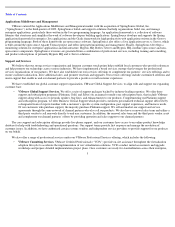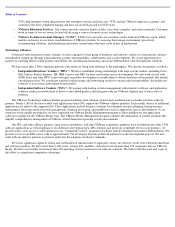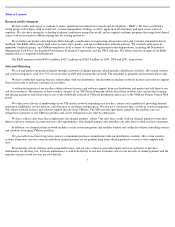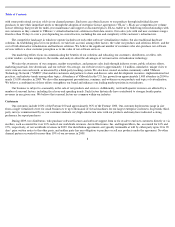VMware 2009 Annual Report Download - page 18
Download and view the complete annual report
Please find page 18 of the 2009 VMware annual report below. You can navigate through the pages in the report by either clicking on the pages listed below, or by using the keyword search tool below to find specific information within the annual report.
Table of Contents
If operating system and hardware vendors do not cooperate with us or we are unable to obtain early access to their new products, or access to
certain information about their new products to ensure that our solutions interoperate with those products, our product development efforts
may be delayed or foreclosed.
Our products interoperate with Windows, Linux and other operating systems and the hardware devices of numerous manufacturers.
Developing products that interoperate properly requires substantial partnering, capital investment and employee resources, as well as the
cooperation of the vendors or developers of the operating systems and hardware. Operating system and hardware vendors may not provide us
with early access to their technology and products, assist us in these development efforts or share with or sell to us any APIs, formats, or
protocols we may need. If they do not provide us with the necessary early access, assistance or proprietary technology on a timely basis, we may
experience product development delays or be unable to expand our products into other areas. To the extent that software or hardware vendors
develop products that compete with ours or those of our controlling stockholder, EMC, they may have an incentive to withhold their cooperation,
decline to share access or sell to us their proprietary APIs, protocols or formats or engage in practices to actively limit the functionality, or
compatibility, and certification of our products. To the extent that we enter into collaborations or joint development and marketing arrangements
with certain hardware and software vendors, vendors who compete with our collaborative partners may similarly choose to limit their
cooperation with us. In addition, hardware or operating system vendors may fail to certify or support or continue to certify or support, our
products for their systems. If any of the foregoing occurs, our product development efforts may be delayed or foreclosed and our business and
results of operations may be adversely affected.
Our product and technology initiatives subject us to additional business, legal and competitive risks.
Since the beginning of 2009, we have announced new product and technology initiatives which aim to leverage our virtualization
infrastructure software products into the emerging areas of cloud and virtual desktop computing as alternatives to the provisioning of physical
computing resources. Additionally, in connection with our September 2009 acquisition of SpringSource, we announced our intention to use
SpringSource solutions to extend VMware’s strategy to deliver solutions in the emerging Platform as a Service (“PaaS”) market. Additionally,
SpringSource’s current offerings and their underlying open source technology position us in the enterprise and web application development and
management markets and our February 2010 acquisition of Zimbra has extended our footprint to cloud-based email and collaboration services.
We also recently announced our vCenter family of products to more fully manage virtualized environments, which may cause us to compete
with other virtualization management vendors.
These initiatives may present new and difficult technology challenges, end users may choose not to adopt our new product or service
offerings, and we may be subject to claims if customers of these offerings experience service disruptions or failures, security breaches or other
quality issues. Further, the success of these new offerings depends upon the cooperation of hardware, software and cloud hosting vendors to
ensure interoperability with our products and offer compatible products and services to end users.
The cloud computing, PaaS and virtual desktop markets are in early stages of development. Other companies seeking to enter and develop
competing standards for the cloud computing market such as Microsoft, IBM, Oracle, Google and Amazon and the virtual desktop market such
as Microsoft and Citrix have introduced or are likely to introduce their own initiatives that may compete with or not be compatible with our
cloud, virtual desktop computing and PaaS initiatives which could limit the degree to which other vendors develop products and services around
our offerings and end users adopt our platforms. Additionally, our operating margins in our newer initiatives may be lower than those we have
achieved in the markets we currently serve, and we may not be successful enough in these newer activities to recoup our investments in them. If
any of this were to occur, it could damage our reputation, limit our growth and negatively affect our operating results.
15
























